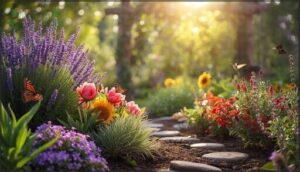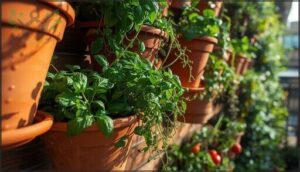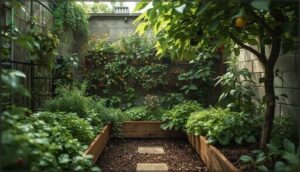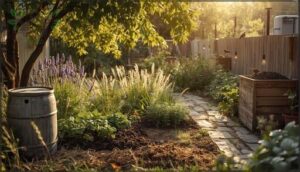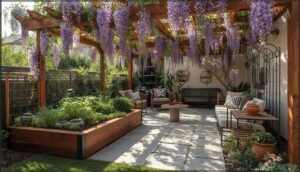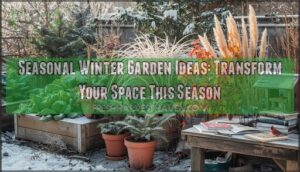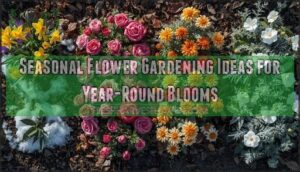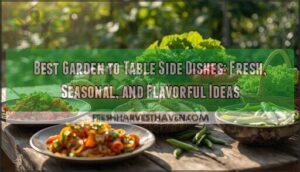This site is supported by our readers. We may earn a commission, at no cost to you, if you purchase through links.
A single square foot of soil can yield over five pounds of fresh vegetables if you know how to plan it right. That’s not just trivia—it’s proof that good garden planning ideas turn even small spaces into productive patches.
Whether you’re working with a sunny backyard, a shady balcony, or a narrow strip beside your porch, the way you design and layer your garden shapes everything from harvests to curb appeal.
Smart layouts, creative plant pairings, and sustainable choices reveal more than beauty—they bring lasting bounty, color, and life to your space. Let’s look at practical ways to make every inch count.
Table Of Contents
Key Takeaways
- Square-foot gardening and vertical structures let you pack serious harvests into tight spaces—up to 130 plants in 16 square feet or 50 plants per vertical square foot—making even balconies and small yards surprisingly productive.
- Companion planting and succession planting work together to naturally reduce pests while extending your harvest season, with strategic pairings like onions and carrots cutting pest damage by half and staggered sowings delivering fresh crops for months instead of weeks.
- Native plants and pollinator-friendly design transform your garden into a low-maintenance ecosystem that supports three times more beneficial species while slashing water use and upkeep costs by up to 80 percent compared to traditional lawns.
- Drip irrigation and rainwater harvesting cut water waste in half while a thousand-square-foot roof can capture 600 gallons per inch of rain, giving you free irrigation and drought resistance without sacrificing plant health or yields.
Creative Vegetable Garden Planning Ideas
Growing your own vegetables doesn’t have to mean endless rows that eat up your entire yard. Smart planning lets you pull off serious harvests in surprisingly small spaces while keeping maintenance simple.
Here are five proven methods that turn any backyard into a productive vegetable garden.
Square-Foot Gardening for Maximum Yield
By dividing a 4-by-4-foot bed into sixteen squares, square-foot gardening transforms tight spaces into productive zones. This efficient space utilization approach means you’ll pack far more plants—up to 130 in just 16 square feet—than traditional rows allow.
Here’s how to best use your garden layout design:
- Planting density matters: Place 16 small crops like carrots per square, 9 medium plants like spinach, 4 large ones like lettuce, or 1 extra-large tomato per square foot
- Soil mix is key: Combine one-third compost, one-third peat moss, and one-third vermiculite for ideal water efficiency and drainage
- Bed depth counts: Fill beds with 6 to 8 inches of soil to support dense root systems
- Weed suppression happens naturally: Close plant spacing shades soil and leaves little room for unwanted growth
You’ll harvest 0.5 to 2 pounds per square foot depending on conditions, and the tightly planted canopy reduces evaporation while your grid simplifies crop rotation throughout the season.
This method is particularly beneficial in small spaces, making square foot gardening ideal for urban gardeners.
Raised Bed Designs for Easy Maintenance
Raised bed gardening builds on that grid-based efficiency with a design that cuts maintenance time in half. When you frame beds 3 to 4 feet wide, you’ll reach the center easily without stepping on soil—preventing compaction and eliminating the need to re-till.
Ergonomic dimensions matter: beds around 24 inches high reduce bending, while 4-foot pathways let wheelchairs and carts move freely between rows for efficient layout planning.
When cutting lumber, remember that standard lumber sizes help minimize waste.
Vertical Gardening to Save Space
When ground space runs out, think upward. Vertical gardening techniques let you stack plants in towers or wall-mounted pockets, multiplying your vegetable garden’s footprint without expanding sideways—studies show you can support up to 50 plants per square foot. These systems excel at yield optimization in tight spots while improving urban air quality and creating microclimate benefits:
- Vertical hydroponics use 98% less water through closed-loop circulation
- Tower setups boost yields 35–50% over soil-based beds
- Living walls absorb up to 85% of ambient noise
- Market growth projections reach $49 billion by 2033
- Small space gardening gains four times the planting surface from one square meter
Vertical garden structures also insulate walls, cutting heating and cooling costs while freeing floor space for seating or pathways. That makes garden space optimization both practical and planet-friendly.
Companion Planting Strategies
Companion planting techniques pair vegetables with flowers and herbs to boost pest suppression and yield effects. For example, intercropping onions with carrots cut carrot fly damage by 52%.
These spatial design choices improve soil health through legume nitrogen-fixing and support pollinators with nectar blooms.
Your companion planting garden turns diversity into a natural advantage, reducing pests while raising overall productivity in flower and vegetable gardens.
Succession Planting for Multiple Harvests
Succession planting schedules sow fast crops like lettuce every two weeks, delivering continuous harvests instead of one big glut. Staggered planting lets you pull spent greens and replant beans or cucumbers at planting intervals of 14 to 21 days.
This vegetable garden planning approach spreads yield across months, maintains soil fertility with compost between cycles, and builds natural crop rotation into your layout for multiple harvests all season.
Inspiring Flower and Sensory Garden Designs
Flower and sensory gardens do more than just look pretty—they engage your senses and bring life to your yard. You can design spaces that offer fresh blooms for cutting, fragrances that change with the seasons, or habitats that welcome pollinators and native wildlife.
Here are some ideas to help you create a garden that’s both beautiful and purposeful.
Perennial Cutting Gardens for Year-Round Blooms
A Perennial Cutting Garden Plan built around bloom sequencing lets you harvest fresh perennial flowers for 9–10 months yearly when you coordinate outdoor beds with indoor bulb forcing.
Species selection matters—choose zone-appropriate plants like coneflowers and iris, then factor in climate considerations for your region.
Pay attention to planting density and bloom quality through deadheading, and you’ll build a cutting garden that rewards you season after season.
Fragrant Garden Ideas for All Seasons
Scent transforms your flower garden into an immersive experience when you layer fragrant plants across all four seasons. Winter fragrance arrives through daphne and sweet box blooming in cold months, while summer perennials like lavender and hyssop carry you through warm weather. Night-scented plants such as Cestrum nocturnum release their strongest perfume after dark, and seasonal herbs like rosemary provide year-round aroma along pathways.
- Plant winter-blooming shrubs near entryways where you’ll catch their subtle perfume on cold mornings
- Cluster summer perennials in sunny borders to intensify scent while attracting pollinators throughout the growing season
- Position night-scented plants beside patios or bedroom windows to enjoy evening fragrance during outdoor gatherings
- Line walkways with seasonal herbs so brushing past releases aromatic oils with every step through your garden layout
Butterfly and Pollinator-Friendly Gardens
Building a butterfly paradise starts with understanding that attracting pollinators requires more than colorful wildflowers. Your pollinator garden needs three essentials: native plants for at least 70% of your space, reliable water sources like shallow birdbaths, and garden structure including rock piles or bare soil patches.
Plan bloom continuity from spring through fall, and embrace pesticide reduction—companion planting naturally protects plants while keeping butterflies safe throughout their lifecycle.
Incorporating Native Wildflowers
Native plants form the backbone of true pollinator support—they’re not just pretty additions but ecosystem powerhouses. A 3-year Oregon study found natives attracted more pollinators than cultivars in 37% of cases, while urban wildflower meadows slashed maintenance costs by 80%.
Your native wildflower choices deliver multiple wins:
- Ecosystem services: Reduce erosion and improve soil fertility naturally
- Economic impacts: Cut installation costs by 50% compared to traditional turf
- Pollinator garden benefits: Support 87.5% of flowering plants dependent on pollinators
- Adoption trends: 34% of gardeners now buy plants specifically for wildlife
- Design considerations: Dense drifts create efficient foraging patches for bees
Attracting pollinators starts with choosing regionally adapted species that flower spring through fall.
Creating a Cottage-Style Flower Garden
A cottage garden thrives on cheerful chaos—dense layers of perennials, self-seeders, and climbers spilling over informal pathways. You’ll want 60–80% long-lived perennials for structure, mixing in annuals for seasonal pops.
Plant diversity attracts wildlife support naturally: cottage-style plots host 2.5 times more pollinators than single-layer beds.
Once established, this approach delivers low maintenance, cutting weeding by a third compared to sparse plantings.
Smart Layouts for Small and Urban Spaces
When you’re working with limited space, every square foot counts. The good news is that small gardens and urban settings can be just as productive as sprawling plots with the right approach.
Here are some practical ways to make the most of tight quarters while keeping your garden thriving year-round.
Container Gardening Solutions
When you’re working with container gardening solutions, you gain real freedom in small space gardening. Vertical containers can multiply your growing surface fourfold, turning one square meter into four productive layers.
Self-watering benefits include cutting water use by half while reducing how often you’ll need to tend plants.
Choose durable container materials like quality resin for balcony gardens—they’re lightweight and support ergonomic designs that let you garden comfortably from any position.
Designing Efficient Balcony or Patio Gardens
After setting up your containers, you’ll want to map out your full balcony or patio garden layout for small space gardening success. Studies show Mumbai balconies dedicating 60% of floor area to planting zones achieve the best results.
Here’s your garden planning checklist:
- Mount rail planters and vertical structures to boost growing area by 50%
- Choose microclimate control spots—track sun, wind, and shade patterns
- Balance container selection with aesthetic integration using coordinated colors
- Leave circulation paths for safe movement and maintenance access
This garden design approach maximizes every inch.
Multi-Layered Planting Systems
You can stack plants vertically to mimic forest gardening right in your urban space. This multilayered garden design combines canopy trees, fruiting shrubs, herbs, and groundcovers to create edible polycultures that support habitat niches for beneficial insects.
Urban implementation is easier than you’d think—documented sites thrive in spaces as compact as 50 square meters, turning your vegetable garden layout into a productive, multi-level ecosystem.
Optimizing Partial-Shade Areas
Partial shade gardening is easier than it sounds. Areas with three to six hours of sun can still produce impressive harvests if you pick crops wisely and understand light level impact.
- Morning sun works better than afternoon light—cooler conditions help leafy greens and shade-tolerant vegetables thrive without wilting
- Peppers produce harvestable fruit at 55% of full sun, though yields peak closer to 85%
- Self-watering containers compensate for reduced light by maintaining consistent moisture in partial-shade gardens
- Position taller plants at the back to capture maximum sunlight exposure while shorter crops benefit from dappled light below
Sustainable and Eco-Friendly Garden Practices
Your garden can do more than just look good—it can also support the environment around you. From conserving water to welcoming wildlife, sustainable practices help you create a space that’s productive and kind to the planet.
Here are five practical ways to make your garden more eco-friendly without sacrificing beauty or yield.
Water-Efficient Drip Irrigation Techniques
Drip irrigation delivers water directly to plant roots, cutting waste by up to 50% compared to sprinklers. This method achieves around 90% efficiency, protecting groundwater while keeping your garden thriving. Soil moisture sensing helps you schedule watering based on real conditions, not guesswork. Watch for emitter clogging risks—flush lines monthly and check system performance regularly to maintain water savings and support drought-resistant gardening through sustainable design and smart garden maintenance.
| Drip Irrigation Advantage | Impact on Your Garden |
|---|---|
| Reduced water use | Up to 50% savings vs. sprinklers |
| Root-zone delivery | 90% efficiency, minimal evaporation |
| Automated scheduling | Soil sensors adjust watering in real time |
Rainwater Harvesting and Recycled Materials
Capturing runoff from your roof turns every rainstorm into a free irrigation resource. A thousand-square-foot roof yields about 600 gallons per inch of rain, meeting a big chunk of your garden’s water needs.
Pair rainwater collection with recycled planters and salvaged materials for raised beds to create sustainable infrastructure.
You’ll support eco-friendly gardening, boost irrigation efficiency, and embrace water-efficient gardening through smart, drought-resistant garden design.
Choosing Drought-Resistant Plants
When you choose drought-resistant plants, you’re making a smart investment in water conservation and lower maintenance needs. Match plants to your soil type and sun exposure—native species with deep roots thrive in dry climates while needing minimal watering after establishment.
Look for drought-tolerant plants with silvery foliage or water-storing capabilities. Many ornamental shrubs offer both drought resistance and appealing aesthetic traits, giving you beauty and efficiency in one choice.
Supporting Beneficial Insects and Wildlife
Want beneficial insects working for your garden? Creating pesticide-free habitats transforms your space into a thriving wildlife sanctuary. Even small gardens support pollinators when you design with intention.
Here’s how to get started:
- Leave some lawn unmown—bee populations thrive with structural diversity
- Add a wildlife pond to support dragonflies and aquatic invertebrates
- Build log piles for beetles, frogs, and decomposers
- Plant native flowers attracting three times more pollinator species
You’re building ecological corridors right in your yard.
Incorporating Native Plants for Biodiversity
Native plants form the backbone of a thriving garden ecosystem. When you fill your space with species adapted to your region, you’re creating wildlife habitat that nourishes three times more pollinator species than exotic ornamentals.
Their deep root systems improve soil health, sequester carbon, and increase water infiltration. This biodiversity conservation approach transforms your garden into a functioning landscape—one that works with nature rather than against it.
Native plants with deep roots enrich soil, store carbon, and help your garden thrive in harmony with nature
Start by replacing just 50–70% of your current plantings with native wildflowers and perennials.
Stylish Garden Features and Functional Elements
Your garden isn’t just about what you grow—it’s also about how you design the space to work for your life. Beyond the plants themselves, thoughtful features and structures can make your garden more beautiful, functional, and welcoming for everyone who uses it.
Let’s explore some practical ways to improve your garden with stylish elements that protect, organize, and bring your outdoor space together.
Garden Barriers for Pet and Child Protection
Your garden barrier is doubly effective: keeping pets contained and children safe. A 4-foot fence generally works for small dogs, while larger breeds need 5-6 feet. Solid panels prevent escape better than chain-link for determined climbers. Bury fencing below grade to stop digging.
Isolate toxic plants like rhubarb and tomato greens behind barriers. Self-closing gates and ground clearance under 1 inch create effective play-area boundaries. Proper barrier standards reduce drowning risk considerably.
Enhancing Home Entrances With Porch Borders
After securing your garden, enhancing your home entrance with porch borders is a smart next step. Plant layering—tall shrubs behind, perennials in the middle, groundcovers up front—creates balanced curb appeal and seasonal interest. Add hardscape elements like stone edging for definition.
Pollinator-friendly flowers near your garden entrance boost visual impact and habitat, making your garden design ideas truly inviting.
Designing Relaxation and Play Areas
Once your porch borders set the tone, think about weaving relaxation and play into your backyard garden layout. Ergonomic seating paired with outdoor structures like pergolas or fire features turns garden beds into true living spaces.
For families, blend natural play with child safety—mulch paths, soft turf, and sturdy barriers—so your garden design ideas work for both quiet moments and active fun.
Adding Water Features for Visual Appeal
After shaping cozy spaces for play and rest, think about weaving water features into your backyard garden. Cast stone fountains or metal scuppers add instant drama and structure.
With LED lighting integration, you can highlight movement and create nighttime ambiance. Water sounds boost sensory effects, mask noise, and attract wildlife, blending ecological aesthetics with smart water efficiency in your landscape design.
Creating Accessible Gardens for All Abilities
After adding water’s soothing touch, think about how everyone can join in the joy of your garden space. Inclusive design isn’t just a trend—it’s practical. Raised beds, wide wheelchair access paths, and adaptive tools open up garden planning for all. Sensory elements—like textured plants—invite everyone to connect with your garden layouts.
- 24–30 inch high raised beds for easy reach
- 36-inch wide, firm pathways for wheelchair access
- Adaptive tools for comfortable gardening
- Sensory elements woven into garden design
Frequently Asked Questions (FAQs)
How do I start a garden from scratch?
Starting from scratch means picking your site first—six to eight hours of sun beats shade every time.
Then prepare soil with compost, plan your layout using square-foot gardening, and space plants densely for maximum yield.
What is the best soil mix for vegetables?
The ideal vegetable garden soil is loam—a balanced blend of sand, silt, and clay that drains well while retaining nutrients. Aim for 3–5% organic matter through compost additions.
For raised beds, mix 60% topsoil, 30% compost, and 10% aeration material.
Check your soil’s pH; most vegetables prefer 0–0.
How can I prevent common garden pests naturally?
Without natural pest control, your garden becomes an all-you-can-eat buffet for insects. Row covers block beetles early on, while trap cropping diverts pests away. Beneficial insects reduce damage by 20–40 percent, and neem oil addresses soft-bodied pests effectively. IPM combines all these tactics for lasting results.
Which tools are essential for beginner gardeners?
You’ll want a hand trowel for digging and planting, hand pruners for cutting, garden gloves for protection, and a watering wand for consistent moisture.
A rake and hoe handle larger tasks as your garden grows.
How do I plan crop rotation in my garden?
You rotate crops by grouping plants into families and moving each group through separate beds every season.
A four-bed layout ensures families return to the same soil only after four years.
Conclusion
The best garden planning ideas often emerge when your space, schedule, and plant choices align just right. What starts as a sketch on paper transforms into fresh harvests, seasonal color, and habitat for pollinators.
You don’t need acres or a master’s degree—just curiosity, a willingness to experiment, and respect for what your soil and light can support.
Every season you tend your garden, you’ll improve what works and discover new ways to make it thrive.


